How to Write a Summary (Examples Included)

By Ashley Shaw

Have you ever recommended a book to someone and given them a quick overview? Then you’ve created a summary before!
Summarizing is a common part of everyday communication. It feels easy when you’re recounting what happened on your favorite show, but what do you do when the information gets a little more complex?
Written summaries come with their own set of challenges. You might ask yourself:
- What details are unnecessary?
- How do you put this in your own words without changing the meaning?
- How close can you get to the original without plagiarizing it?
- How long should it be?
The answers to these questions depend on the type of summary you are doing and why you are doing it.
A summary in an academic setting is different to a professional summary—and both of those are very different to summarizing a funny story you want to tell your friends.
One thing they all have in common is that you need to relay information in the clearest way possible to help your reader understand. We’ll look at some different forms of summary, and give you some tips on each.
Let’s get started!

What Is a Summary?
How do you write a summary, how do you write an academic summary, what are the four types of academic summaries, how do i write a professional summary, writing or telling a summary in personal situations, summarizing summaries.
A summary is a shorter version of a larger work. Summaries are used at some level in almost every writing task, from formal documents to personal messages.
When you write a summary, you have an audience that doesn’t know every single thing you know.
When you want them to understand your argument, topic, or stance, you may need to explain some things to catch them up.
Instead of having them read the article or hear every single detail of the story or event, you instead give them a brief overview of what they need to know.
Academic, professional, and personal summaries each require you to consider different things, but there are some key rules they all have in common.
Let’s go over a few general guides to writing a summary first.
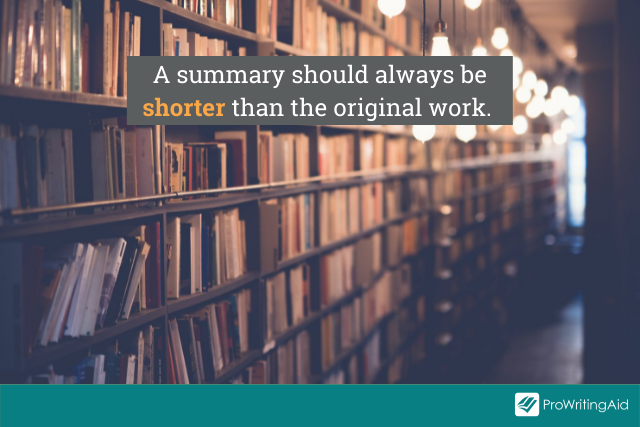
1. A summary should always be shorter than the original work, usually considerably.
Even if your summary is the length of a full paper, you are likely summarizing a book or other significantly longer work.
2. A summary should tell the reader the highlights of what they need to know without giving them unnecessary details.
3. It should also include enough details to give a clear and honest picture.
For example, if you summarize an article that says “ The Office is the greatest television show of all time,” but don’t mention that they are specifically referring to sitcoms, then you changed the meaning of the article. That’s a problem! Similarly, if you write a summary of your job history and say you volunteered at a hospital for the last three years, but you don’t add that you only went twice in that time, it becomes a little dishonest.
4. Summaries shouldn’t contain personal opinion.
While in the longer work you are creating you might use opinion, within the summary itself, you should avoid all personal opinion. A summary is different than a review. In this moment, you aren’t saying what you think of the work you are summarizing, you are just giving your audience enough information to know what the work says or did.
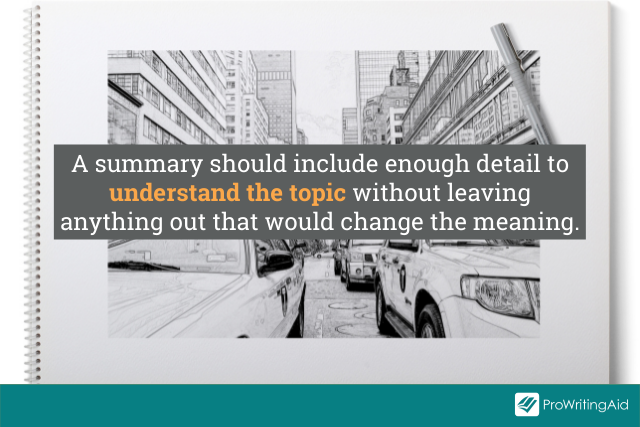
Now that we have a good idea of what summaries are in general, let’s talk about some specific types of summary you will likely have to do at some point in your writing life.
An academic summary is one you will create for a class or in other academic writing. The exact elements you will need to include depend on the assignment itself.
However, when you’re asked for an academic summary, this usually this means one of five things, all of which are pretty similar:
- You need to do a presentation in which you talk about an article, book, or report.
- You write a summary paper in which the entire paper is a summary of a specific work.
- You summarize a class discussion, lesson, or reading in the form of personal notes or a discussion board post.
- You do something like an annotated bibliography where you write short summaries of multiple works in preparation of a longer assignment.
- You write quick summaries within the body of another assignment . For example, in an argumentative essay, you will likely need to have short summaries of the sources you use to explain their argument before getting into how the source helps you prove your point.
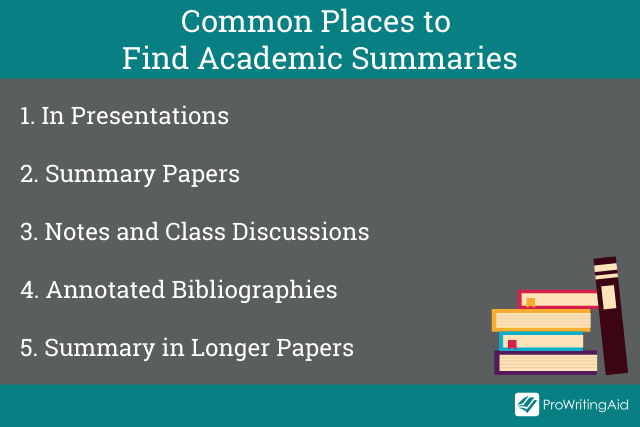
Regardless of what type of summary you are doing, though, there are a few steps you should always follow:
- Skim the work you are summarizing before you read it. Notice what stands out to you.
- Next, read it in depth . Do the same things stand out?
- Put the full text away and write in a few sentences what the main idea or point was.
- Go back and compare to make sure you didn’t forget anything.
- Expand on this to write and then edit your summary.
Each type of academic summary requires slightly different things. Let’s get down to details.
How Do I Write a Summary Paper?
Sometimes teachers assign something called a summary paper . In this, the entire thing is a summary of one article, book, story, or report.
To understand how to write this paper, let’s talk a little bit about the purpose of such an assignment.
A summary paper is usually given to help a teacher see how well a student understands a reading assignment, but also to help the student digest the reading. Sometimes, it can be difficult to understand things we read right away.
However, a good way to process the information is to put it in our own words. That is the point of a summary paper.
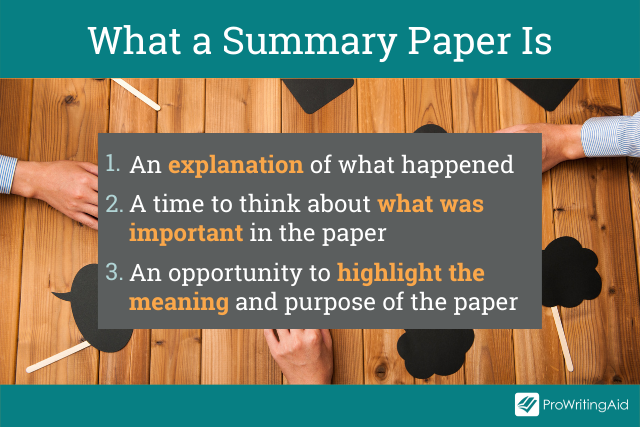
A summary paper is:
- A way to explain in our own words what happened in a paper, book, etc.
- A time to think about what was important in the paper, etc.
- A time to think about the meaning and purpose behind the paper, etc.
Here are some things that a summary paper is not:
- A review. Your thoughts and opinions on the thing you are summarizing don’t need to be here unless otherwise specified.
- A comparison. A comparison paper has a lot of summary in it, but it is different than a summary paper. In this, you are just saying what happened, but you aren’t saying places it could have been done differently.
- A paraphrase (though you might have a little paraphrasing in there). In the section on using summary in longer papers, I talk more about the difference between summaries, paraphrases, and quotes.
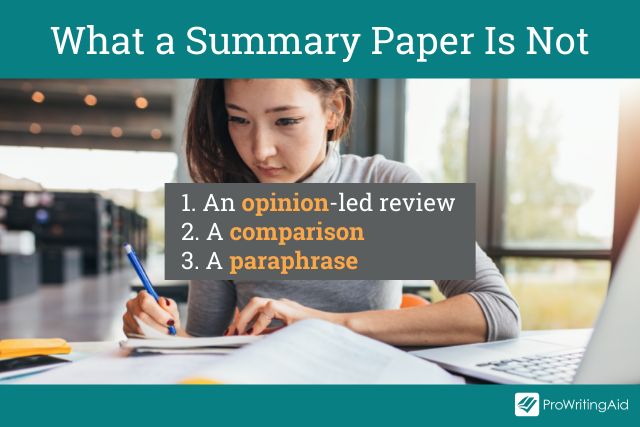
Because a summary paper is usually longer than other forms of summary, you will be able to chose more detail. However, it still needs to focus on the important events. Summary papers are usually shorter papers.
Let’s say you are writing a 3–4 page summary. You are likely summarizing a full book or an article or short story, which will be much longer than 3–4 pages.
Imagine that you are the author of the work, and your editor comes to you and says they love what you wrote, but they need it to be 3–4 pages instead.
How would you tell that story (argument, idea, etc.) in that length without losing the heart or intent behind it? That is what belongs in a summary paper.
How Do I Write Useful Academic Notes?
Sometimes, you need to write a summary for yourself in the form of notes or for your classmates in the form of a discussion post.
You might not think you need a specific approach for this. After all, only you are going to see it.
However, summarizing for yourself can sometimes be the most difficult type of summary. If you try to write down everything your teacher says, your hand will cramp and you’ll likely miss a lot.
Yet, transcribing doesn’t work because studies show that writing things down (not typing them) actually helps you remember them better.
So how do you find the balance between summarizing the lessons without leaving out important points?
There are some tips for this:
- If your professor writes it on the board, it is probably important.
- What points do your textbooks include when summarizing information? Use these as a guide.
- Write the highlight of every X amount of time, with X being the time you can go without missing anything or getting tired. This could be one point per minute, or three per five minutes, etc.
How Do I Create an Annotated Biography?
An annotated bibliography requires a very specific style of writing. Often, you will write these before a longer research paper . They will ask you to find a certain amount of articles and write a short annotation for each of them.
While an annotation is more than just a summary, it usually starts with a summary of the work. This will be about 2–3 sentences long. Because you don’t have a lot of room, you really have to think about what the most important thing the work says is.
This will basically ask you to explain the point of the article in these couple of sentences, so you should focus on the main point when expressing it.
Here is an example of a summary section within an annotation about this post:
“In this post, the author explains how to write a summary in different types of settings. She walks through academic, professional, and personal summaries. Ultimately, she claims that summaries should be short explanations that get the audience caught up on the topic without leaving out details that would change the meaning.”

Can I Write a Summary Within an Essay?
Perhaps the most common type of summary you will ever do is a short summary within a longer paper.
For example, if you have to write an argumentative essay, you will likely need to use sources to help support your argument.
However, there is a good chance that your readers won’t have read those same sources.
So, you need to give them enough detail to understand your topic without spending too much time explaining and not enough making your argument.
While this depends on exactly how you are using summary in your paper, often, a good amount of summary is the same amount you would put in an annotation.
Just a few sentences will allow the reader to get an idea of the work before moving on to specific parts of it that might help your argument.
What’s the Difference Between Summarizing, Paraphrasing, and Using Quotes?
One important thing to recognize when using summaries in academic settings is that summaries are different than paraphrases or quotes.
A summary is broader and more general. A paraphrase, on the other hand, puts specific parts into your own words. A quote uses the exact words of the original. All of them, however, need to be cited.
Let’s look at an example:
Take these words by Thomas J. Watson:
”Would you like me to give you a formula for success? It’s quite simple, really. Double your rate of failure. You are thinking of failure as the enemy of success. But it isn’t as all. You can be discouraged by failure—or you can learn from it. So go ahead and make mistakes. Make all you can. Because, remember, that’s where you will find success.”
Let’s say I was told to write a summary, a paraphrase, and a quote about this statement. This is what it might look like:
Summary: Thomas J. Watson said that the key to success is actually to fail more often. (This is broad and doesn’t go into details about what he says, but it still gives him credit.)
Paraphrase: Thomas J. Watson, on asking if people would like his formula for success, said that the secret was to fail twice as much. He claimed that when you decide to learn from your mistakes instead of being disappointed by them, and when you start making a lot of them, you will actually find more success. (This includes most of the details, but it is in my own words, while still crediting the source.)
Quote: Thomas J. Watson said, ”Would you like me to give you a formula for success? It’s quite simple, really. Double your rate of failure. You are thinking of failure as the enemy of success. But it isn’t at all. You can be discouraged by failure—or you can learn from it. So go ahead and make mistakes. Make all you can. Because, remember, that’s where you will find success.” (This is the exact words of the original with quotation marks and credit given.)
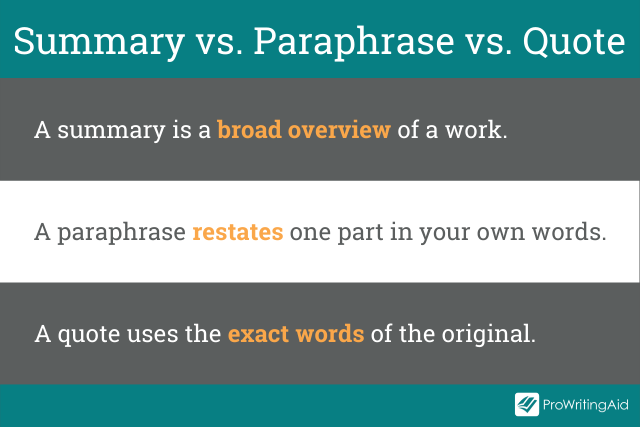
Avoiding Plagiarism
One of the hardest parts about summarizing someone else’s writing is avoiding plagiarism .

That’s why I have a few rules/tips for you when summarizing anything:
1. Always cite.
If you are talking about someone else’s work in any means, cite your source. If you are summarizing the entire work, all you probably need to do (depending on style guidelines) is say the author’s name. However, if you are summarizing a specific chapter or section, you should state that specifically. Finally, you should make sure to include it in your Work Cited or Reference page.
2. Change the wording.
Sometimes when people are summarizing or paraphrasing a work, they get too close to the original, and actually use the exact words. Unless you use quotation marks, this is plagiarism. However, a good way to avoid this is to hide the article while you are summarizing it. If you don’t have it in front of you, you are less likely to accidentally use the exact words. (However, after you are done, double check that you didn’t miss anything important or give wrong details.)
3. Use a plagiarism checker.
Of course, when you are writing any summary, especially academic summaries, it can be easy to cross the line into plagiarism. If this is a place where you struggle, then ProWritingAid can help.
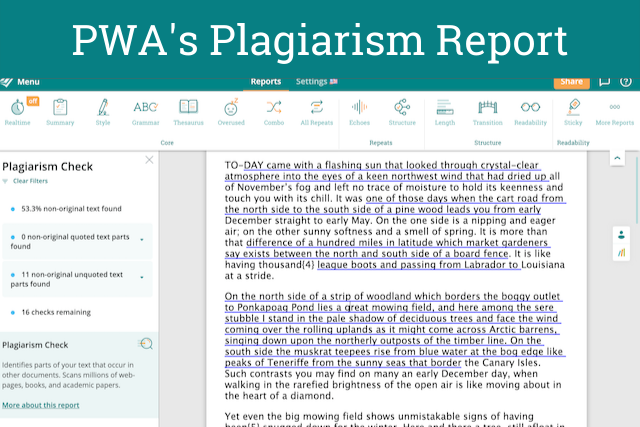
Just use our Plagiarism Report . It’ll highlight any unoriginal text in your document so you can make sure you are citing everything correctly and summarizing in your own words.
Find out more about ProWritingAid plagiarism bundles.
Along with academic summaries, you might sometimes need to write professional summaries. Often, this means writing a summary about yourself that shows why you are qualified for a position or organization.
In this section, let’s talk about two types of professional summaries: a LinkedIn summary and a summary section within a resume.
How Do I Write My LinkedIn Bio?
LinkedIn is all about professional networking. It offers you a chance to share a brief glimpse of your professional qualifications in a paragraph or two.
This can then be sent to professional connections, or even found by them without you having to reach out. This can help you get a job or build your network.
Your summary is one of the first things a future employer might see about you, and how you write yours can make you stand out from the competition.

Here are some tips on writing a LinkedIn summary :
- Before you write it, think about what you want it to do . If you are looking for a job, what kind of job? What have you done in your past that would stand out to someone hiring for that position? That is what you will want to focus on in your summary.
- Be professional . Unlike many social media platforms, LinkedIn has a reputation for being more formal. Your summary should reflect that to some extent.
- Use keywords . Your summary is searchable, so using keywords that a recruiter might be searching for can help them find you.
- Focus on the start . LinkedIn shows the first 300 characters automatically, and then offers the viewer a chance to read more. Make that start so good that everyone wants to keep reading.
- Focus on accomplishments . Think of your life like a series of albums, and this is your speciality “Greatest Hits” album. What “songs” are you putting on it?
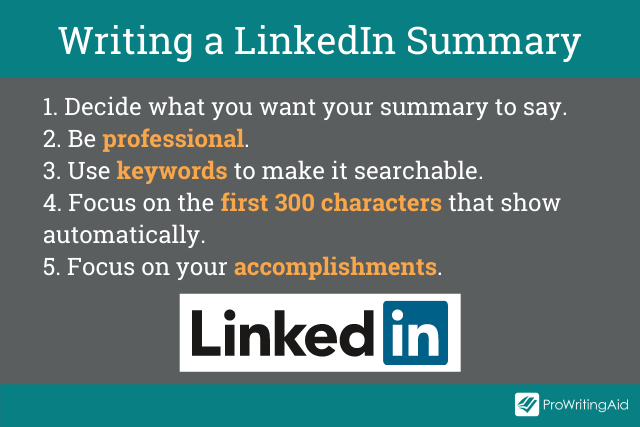
How Do I Summarize My Experience on a Resume?
Writing a professional summary for a resume is different than any other type of summary that you may have to do.
Recruiters go through a lot of resumes every day. They don’t have time to spend ages reading yours, which means you have to wow them quickly.
To do that, you might include a section at the top of your resume that acts almost as an elevator pitch: That one thing you might say to a recruiter to get them to want to talk to you if you only had a 30-second elevator ride.
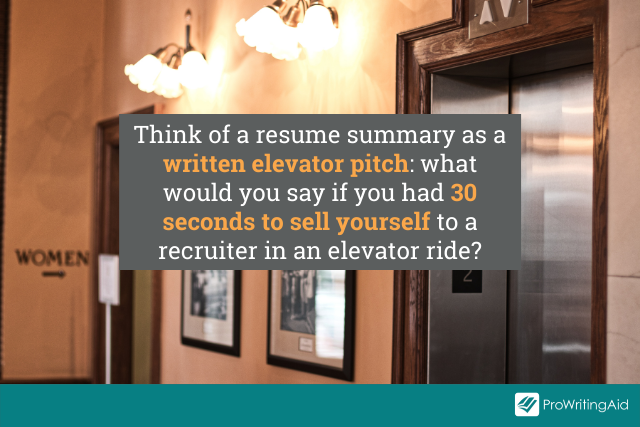
If you don’t have a lot of experience, though, you might want to skip this section entirely and focus on playing up the experience you do have.
Outside of academic and personal summaries, you use summary a lot in your day-to-day life.
Whether it is telling a good piece of trivia you just learned or a funny story that happened to you, or even setting the stage in creative writing, you summarize all the time.
How you use summary can be an important consideration in whether people want to read your work (or listen to you talk).
Here are some things to think about when telling a story:
- Pick interesting details . Too many and your point will be lost. Not enough, and you didn’t paint the scene or give them a complete idea about what happened.
- Play into the emotions . When telling a story, you want more information than the bare minimum. You want your reader to get the emotion of the story. That requires a little bit more work to accomplish.
- Focus. A summary of one story can lead to another can lead to another. Think about storytellers that you know that go off on a tangent. They never seem to finish one story without telling 100 others!

To wrap up (and to demonstrate everything I just talked about), let’s summarize this post into its most essential parts:
A summary is a great way to quickly give your audience the information they need to understand the topic you are discussing without having to know every detail.
How you write a summary is different depending on what type of summary you are doing:
- An academic summary usually gets to the heart of an article, book, or journal, and it should highlight the main points in your own words. How long it should be depends on the type of assignment it is.
- A professional summary highlights you and your professional, academic, and volunteer history. It shows people in your professional network who you are and why they should hire you, work with you, use your talents, etc.
Being able to tell a good story is another form of summary. You want to tell engaging anecdotes and facts without boring your listeners. This is a skill that is developed over time.
Take your writing to the next level:

20 Editing Tips from Professional Writers
Whether you are writing a novel, essay, article, or email, good writing is an essential part of communicating your ideas., this guide contains the 20 most important writing tips and techniques from a wide range of professional writers..

Be confident about grammar
Check every email, essay, or story for grammar mistakes. Fix them before you press send.
Ashley Shaw
Ashley Shaw is a former editor and marketer/current PhD student and teacher. When she isn't studying con artists for her dissertation, she's thinking of new ways to help college students better understand and love the writing process. You can follow her on Twitter, or, if you prefer animal accounts, follow her rabbits, Audrey Hopbun and Fredra StaHare, on Instagram.
Get started with ProWritingAid
Visit our Help Center or let's stay in touch via:
how to write a summary
A step-by-step guide to writing a great summary.
A summary of a literary work isn't just a plain-old synopsis. It's a valuable study tool, a foundational element of all kinds of essays, a common testing mechanism, and one of the basics of literary analysis.
Whether you're in high school or college, developing a deep understanding of how and when to summarize a book or text is a valuable skill. Doing so might require a little more knowledge and effort than you'd think.
That's why we're covering all aspects of summaries, from study tools to plot summaries, below.
What Is a Summary?
A summary is a brief overview of a text (or movie, speech, podcast, etcetera) that succinctly and comprehensively covers the main ideas or plot points.
Sounds simple, right? Well, there are a lot of unique characteristics that differentiate summaries from other commentary, such as analyses, book reviews, or outlines.
Summaries are:
- In your own words. It's important that you don't just copy and paste the writer's words (in fact, that's plagiarizing). Writing the key points of a work in your own words indicates your comprehension and absorption of the material.
- Objective. While a summary should be in your own words, it shouldn't contain your opinions. Instead, you should gather the main points and intentions of the writer and present them impartially. (If you include your opinions, it instead becomes an analysis or review.)
- More than paraphrasing. Many students fall into the trap of simply paraphrasing—plainly restating the ideas or events of the work. (Is our definition starting to sound contradictory? We told you it wasn't straightforward!) Rather than recounting the events or ideas in a work chronologically or in the order they're presented, instead consider the broad scope of how they all contribute to the narrative or argument.
- Short. There are no strict rules regarding length, only that it is concise. It's largely dependent on the length of the text it summarizes: longer texts, longer summaries. It also depends on the assignment or objective. However, most are about one to two paragraphs in length.
- Comprehensive. Yes, it's another seemingly contradictory descriptor, but an important one. Summaries are comprehensive, meaning they cover all of the main plot points or ideas in a work (so they inherently contain "spoilers"). You should present those ideas in a way that condenses them into an inclusive, but not exhaustive, recounting in order to keep it short.
- Straightforward (even if the text isn't). A good summary should be easy to comprehend, presenting the reader with a simple but all-encompassing understanding of the work at hand. With complex texts, summaries can be particularly useful because they distill big, complicated ideas into a bite-sized package.
When to Write a Summary
Like so many elements of literary analysis, summaries are misunderstood. We've already explained why they aren't as simple as most people think, but neither are their uses.
Summary writing is a useful skill in a variety of circumstances, both in and outside the English and Language Arts classrooms.
Readers, writers, teachers, and students can use summaries:
- As a study tactic. The ability to summarize a book or text indicates that you've absorbed and understand the material. Plus, writing down notes (as in a summary) is a great way to retain material. Try summarizing at the end of a book chapter, after each section of an article, or periodically in textbooks. Doing so will help you digest the material you've just read, confirming you understood and retained the information therein. Stopping frequently to summarize is most effective because you're less likely to forget important plot points or ideas.
- As an assignment. Teachers and professors often ask students to summarize a text as a test to confirm they read and understood the material. Before heading into class—especially if you have a test or quiz scheduled—try practicing summarizing the text. Write it down (rather than practicing it out loud or in your head) so that you can review your ideas and ensure you're presenting them succinctly and sensibly.
- As part of an essay. If you're referencing a book or article in your own paper, you might need to summarize the source as the foundation for your argument. In this case, your summary should be particularly short so the reader doesn't lose sight of your own argument and intention. Introduce the name of the work and its author, then use one sentence (two at most) to describe their objective and how it relates to your own.
- As part of a review. Summaries are very useful in an academic setting, but they have their place outside of it too. Whether you're on a book review site or just sharing a recommendation with a friend, being able to succinctly write a book summary (with or without spoilers) will help others to make their own judgements of a book.
Your Step-by-Step Guide for How to Write a Summary
Step 1: read the work .
Summaries are often perceived as a workaround for reading the work itself. That's not a great strategy under most circumstances because you tend to lose a lot of the details and nuance of a work, but it's particularly impractical to do so when writing about the work.
Remember, a summary is supposed to present your perception of the work as a whole. So in order to develop that perception, you have to first read the original text.

Step 2: Take Notes
As you read the work, simultaneously take notes. If you own the book, it might be helpful to add your notes to the margins or highlight passages that are particularly relevant or capture a key idea. If you don't own the book, try taking notes on your computer or in a notebook. You can still notate important passages by writing down the page and paragraph number or writing an abbreviated version of the quotation. Alternatively, try marking key passages with sticky notes or tabs.
It might also be helpful to write out a short outline of the work as you go. While you won't want to use this verbatim (remember, you shouldn't just paraphrase the work), it can help you establish and remember the text's framework.
Step 3: Identify the Author's Thesis Statement, Objective, or Main Point
In some works, such as a journal article, a writer will provide a thesis statement. A thesis statement is a one-sentence synopsis of the author's argument and intention. A thesis statement can be really helpful in forming the backbone of your own summary, just as it forms the backbone of the essay.
However, even when a thesis statement isn't present—like in a novel—the writer always has an objective or main idea. You should always identify this idea and use it to form the foundation of your summary.
The main point might be apparent at the outset of the work. Other times, the author won't present it until the conclusion. Sometimes you might identify multiple objectives throughout the work. That's why it's important, as you read, to note any ideas that might be the main idea. Even those that aren't the most important will likely remain relevant.
Step 4: Note Other Important Elements
If something stands out to you about the work and seems to play an important role in the text's overall narrative or structure, make a note about it. This could be a recurring theme, an incident in the storyline, or a deviation from the overall argument.
As you identify and note important elements and moments in the work, the structure of your summary should begin to fall into place.
Step 5: Prepare to Write Your Summary
Once you've finished reading the work, review your notes and highlight the key points that came to light. Remember, your summary should be objective, so disregard any opinions you might have noted about the work. You should introduce the thesis or objective, briefly encapsulate the important ideas and moments from the work, and end with a conclusion that ties those ideas to the objective. Keep this structure in mind as you begin.
Step 6: Begin by Introducing the Work
As you begin, introduce the work, its author, and, if relevant, the context.
Depending on your situation—for example, if your teacher or professor has asked you to summarize a work as part of an assignment or quiz—this might seem redundant. However, it is standard practice to begin by introducing the work, even if the reader already knows what you're writing about.
Example: In The Great Gatsby , F. Scott Fitzgerald...
Step 7: Present the Thesis, Main Idea, or Central Argument
Once you've introduced the work, your priority is to clearly define the author's thesis, important point, or central argument. As mentioned above, sometimes the author presents this idea clearly and succinctly at the outset of their work; at other times, it's buried deep in the text.
Regardless of how the main idea is presented in the work, it should be front and center in your summary. Some teachers might refer to this as a "topic sentence" or "introductory sentence." This is the central point around which you will construct the rest of your writing. As you progress, you'll highlight other ideas or occurrences that relate or contribute to this main idea, so it's important that your representation of it is easily understood.
Example: In The Great Gatsby , F. Scott Fitzgerald uses the story of Jay Gatsby as a symbol of the social stratification, greed, and indulgence of 1920s America.
Step 8: Briefly Discuss the Important Elements of the Work
After identifying the thesis or central argument, you should provide a brief overview of the work's other elements, ideas, and plot points. For the most part, the information you present throughout this section should bolster the thesis presented previously. Each sentence should serve as a supporting point for the topic sentence. Don't simply list ideas or plot points, but show how they're connected and inform the work as a whole. Of course, there may also be important elements of the work that are not directly tied to the main idea; it's ok to include these if you feel they are vital to understanding the work.
When writing the body, you should consciously and intentionally leave out unnecessary details. They tend to bog down your writing and lose the reader.
Example: The narrator, Nick Carraway, moves to New York's "West Egg," where he reunites with his cousin, Daisy, and her husband, Tom Buchanan. Fitzgerald clearly delineates social lines between West Egg (new money) and East Egg (old money), where Tom and Daisy reside.
Nick attends a lavish party thrown by his neighbor, Jay Gatsby, and learns Jay formerly had a relationship with Daisy. The two reignite their forbidden affair. Tom reveals to Daisy that Gatsby earned his money illegally, through smuggling alcohol, and is actually a man of humble Midwestern origins. Daisy and Gatsby try to run away together, but Daisy accidentally runs over Tom's mistress. Tom, eager to exact revenge, convinces his mistress' husband that Gatsby was to blame in her death, and he murders Gatsby before committing suicide. Few of Gatsby's many friends attend his funeral.
Step 9: Write a Conclusion that Ties It All Together
Much like you introduce the author's major point at the outset of your summary, you should revisit it as you close out your writing. If you presented the author's main idea in the introduction, and then bolstered that main idea by recollecting plot points or important elements from the work, your conclusion should then reiterate how those elements relate to the main idea.
Example: Though Gatsby subscribed to the extravagance of his peers, his efforts to fit into the upper echelon of West and East Egg were negated by his humble origins; always out of place, he was rejected for his social class as much as his perceived crimes.
Step 10: Edit
Before submitting your work, read it in full, and edit out any superfluous and redundant information. It's likely that unnecessary details snuck in as you were writing, and you might find that certain plot points just feel unnecessary within the scope of your finished product.
In addition to editing for content, be sure to edit it closely for grammatical or spelling errors. Even if your summary is well thought out, its expertise is compromised if it's full of errors!
How to Write a Plot Summary
The step-by-step guide to writing an effective summary, outlined above, applies to most summaries. However, each type has its own unique elements outside of those standard requirements.
A plot or book summary, for example, should encapsulate the plot of a short story or novel. When writing one, there are unique strategies to follow.
Dos of Writing a Plot Summary
- Note plot points as the book or story unfolds. Especially in longer novels, it can be difficult to keep track of the twists and turns in the storyline. That's why we recommend taking notes as you read.
- Use online study guides for inspiration. Websites like SuperSummary provide in-depth summaries free of charge. While this is a good starting point when writing your own, it should only be for inspiration. Don't copy examples online (that's plagiarism!).
- Be sure to cover the three main arcs of every story: the exposition, climax, and conclusion. The exposition is the moment when the conflict or driving narrative is introduced. The climax is when that conflict comes to a head, and the narrative reaches its most dramatic moments. The conclusion is when the conflict is resolved or the story comes to an end. You should also include any inciting incidents (the first domino in a plot point).
- Connect the dots. Throughout, you should demonstrate an understanding of how events and characters are related, rather than introducing each element as an independent variable. Remember, you should tie each plot point back to the main idea.
Don'ts of Writing a Plot Summary
- Don't just regurgitate the storyline. Rather than drone through the story plot point by plot point, you should highlight key moments in the narrative and direct them back to the author's objective.
- Avoid repetitive phrases like "then" or "next." A key indication you're just repeating the storyline point by point is utilizing a phrase like "then" or "next." While you should recount the major incidents of the narrative, it shouldn't feel so formulaic.
- Don't let it drag on. Books are long, but summarizing a book should still be short. While it depends on the assignment and the work in question, your summary should be 200 to 600 words, max.
Example : In The Great Gatsby , F. Scott Fitzgerald uses the story of Jay Gatsby as a symbol of the social stratification, greed, and indulgence of 1920s America. The narrator, Nick Carraway, moves to New York's "West Egg," where he reunites with his cousin, Daisy, and her husband, Tom Buchanan. Fitzgerald clearly delineates social lines between West Egg (new money) and East Egg (old money), where Tom and Daisy reside.
Nick attends a lavish party thrown by his neighbor, Jay Gatsby, and learns he formerly had a relationship with Daisy. When the two reignite their forbidden affair, disaster ensues. Tom reveals to Daisy that Gatsby earned his money illegally, through smuggling alcohol, and is actually a man of humble Midwestern origins. Daisy and Gatsby try to run away together, but Daisy accidentally runs over Tom's mistress. Tom, eager to exact revenge, convinces his mistress' husband that Gatsby was to blame in her death, and he murders Gatsby before committing suicide. Few of Gatsby's many friends attend his funeral.
Though Gatsby subscribed to the extravagance of his peers, his efforts to fit into the upper echelon of West and East Egg were negated by his humble origins; always out of place, he was rejected for his social class as much as his perceived crimes.
For an in-depth analysis of The Great Gatsby , check out the our study guide (we have an audio guide, too!).
How to Summarize an Article or Essay
The nature of an article or essay is quite different from a novel or short story, and in many ways, your summary should be too. The outline above remains the same, but the details are different.
Here's what you should and shouldn't do when writing your article summary.
Dos of Writing an Article Summary
- Skim the original article first. To develop a basic understanding of the article and the writer's objectives, skim the content before reading it closely. Doing so will help you to identify some of the key points and then pay attention to the arguments around them when you read the article in full.
- Then read the article closely, marking key passages and ideas. Noting important ideas as you read will help you develop a deeper understanding of the writer's intentions.
- Note headings and subheadings, which likely identify important points. In articles and essays, the author often utilizes subheadings to introduce their most important ideas. These subheadings can help guide your own writing.
- Keep it short. The rule of brevity applies to article summaries too. In fact, because articles are usually short compared to novels or books, your text should be correlatively brief. And if you're utilizing the work as part of your own essay or argument, just a couple sentences will do.
Don'ts of Writing an Article Summary
- Don't ignore the conclusion. When reading a long article or essay, it can be tempting to overlook the conclusion and focus on the body paragraphs of the article. However, the conclusion is often where the author most clearly outlines their findings and why they matter. It can serve as a great foundation for your own writing.
- Don't copy anything from the article directly—always paraphrase. If you copy any passages word-for-word from the article, be sure to identify them as quotations and attribute them to the author. Even this should be done sparingly. Instead, you should encapsulate their ideas within your own, abbreviated words.
- Don't forget to include proper citations. If you do include a direct quotation from the article, be sure to properly cite them. You can learn how to properly cite quotations in our Academic Citation Resource Guide .
Example Summary of "Gatsby as a Drowned Sailor" : In her essay, "Gatsby as a Drowned Sailor," Margaret Lukens posits that a major, and often overlooked, motif in The Great Gatsby is that of the "drowned sailor." The novel, she points out, is immersed in nautical symbols and themes, particularly in the scenes surrounding Jay Gatsby. For example, Gatsby grew up on the shores of Lake Superior, now owns a house on the Long Island Sound, and supposedly spends much of his time on his boat.
Lukens nods to the nautical imagery throughout Gatsby's lavish party, as well as Nick's interactions with Gatsby. Many of these, she argues, foreshadow Gatsby's death in his pool. Even his funeral is a testament to the motif, with the few attendees soaked to the skin with rain. Lukens presents a thorough case for the overarching nautical motif in The Great Gatsby and her argument that though Gatsby hooked a big one, ultimately it was "the one that got away."
FAQs: How to Write a Book Summary
How do you summarize without plagiarizing .
By its very nature, a summary isn't plagiarizing because it should be written in your own words. However, there are cases where it might be difficult to identify an appropriate synonym, and the phrase remains somewhat close to the original. In this scenario, just be sure to differentiate the rest of the phrase as much as possible. And if you need to include a direct quote from the work, be sure to appropriately cite it.
How to write a summary and a reaction?
In some cases, your teacher may ask you to write a summary and a reaction. Whereas a summary is objective, a reaction is a matter of opinion. So in this case, you should present the actions or ideas of the work, then respond to those actions and ideas with your personal thoughts.
Why write a summary?
A summary is a helpful tool many educators use to test their students' comprehension of a text. However, it is also a useful study tactic because recounting what you read can help you organize and retain information.

IMAGES
VIDEO